Abstract
The wavelet analysis is a powerful tool for analyzing and detecting features of signals characterized by time-dependent statistical properties, as biomedical signals. The identification and the analysis of the components of these signals in the time–frequency domain, give meaningful information about the physiological mechanisms that govern them. This article presents the results of the wavelet analysis applied to the a-wave component of the human electroretinogram. In order to deepen and improve our knowledge about the behavior of the early photoreceptoral response, including the possible activation of interactions and correlations among the photoreceptors, we have detected and identified the stable time–frequency components of the a-wave, using six representative values of luminance. The results indicate the occurrence of three frequencies lying in the range 20–200 Hz. The lowest one is attributed to the summed activities of the photoreceptors. The others are weaker and at low luminance one of them does not occur. We relate them to the response of the rods and the cones whose aggregate activities are non-linear and typically exhibit self-organization under selective stimuli. The identification of the stable frequency components and of their times of occurrence helps us to shine light about the complex mechanisms governing the a-wave. The present results are promising toward the assessment of more refined model concerning the photoreceptoral activities.






Similar content being viewed by others
References
Astaf’eva NM (1996) Wavelet analysis: basic theory and some applications. Physics Uspekhi Fizicheskikih Nauk 39:1085–1108
Barraco R, Bellomonte L, Brai M, Anastasi M (2006) Analysis of the human a-wave ERG-component. Physiol Meas 27:881–899
Barraco R, Persano Adorno D, Bellomonte L, Brai M (2009) A study of the human rod and cone ERG a-wave component. J Stat Mech. doi:10.1088/1742-5468/2009/03/P03007
Bisegna P, Caruso G, Andreucci D, Vsevolod LS, Gurevich V, Hamm HE, Di Benedetto E (2008) Diffusion of the second messengers in the cytoplasm acts as a variability suppressor of the single photon response in vertebrate phototransduction. Biophys J 3363–3383
Burns ME, Lamb TD (2003) Visual transduction by rod and cone photoreceptors. In: Chalupa LM and Werner JS (eds) The visual neurosciences, pp 215–233
Cideciyan AV, Jacobson SG (1996) An alternative phototransduction model for human rod and cone ERG a-waves: normal parameters and variation with age. Vis Res 36:2609–2621
Colon Velez MA, Hernandez DJ, Rodriguez Bernier U, Van Laarhoven J, Camacho E (2003) Technical Report BU-1640-M 1
Daubechies I (1992) Ten lectures on wavelets. Society of industrial and applied mathematics edition. SAM Publications, Philadelphia, PA
Durka PJ (2003) From wavelets to adaptive approximations: time-frequency parametrization of EEG. Biomed Eng Online 2:1
Forte JD, Bui BV, Vingrys AJ (2008) Wavelet analysis reveals dynamics of rat oscillatory potential. J Neurosci Methods 169:191–200
Granit R (1933) The components of the retinal action potential in mammals and their relation to the discharge in the optic nerve. J Physiol (London) 77:207–239
Hood D, Birch DG (1990) A quantitative measure of electrical activity of the human rod photoreceptors using electroretinography. Vis Neurosci 5:379–387
Hood D, Birch DG (1993a) Light adaptation of human rod receptors: the leading edge of the human a.wave and models of rod receptor activity. Vis Res 33:1605–1618
Hood D, Birch DG (1993b) Human cone photoreceptor activity-the a-wave and models of receptor activity. Vis Neurosci 10:857–871
Hu X, Yu Q, Liu W, Qin J (2008) Feature extraction of surface EMG signal based on wavelet coefficient entropy, IEEE Xplore 978-1-4244-1748-3/08
Jedrzejczak WW, Blinowska KJ, Konopka W (2005) Time-frequency analysis of transiently evoked otoacoustic emissions of subjects exposed to noise. Hearing Res 205:249–255
Kilby J, Gholam Hosseini H (2006) Extracting effective features of SEMG using continuous wavelet transform. In: Proceedings of the 28th IEEE EMBS annual international conference, New York City, USA, Aug 30–Sept 3, 2006
Lamb TD, Pugh EN (1992) A quantitative account of the activation steps involved in phototransduction in amphibian photoreceptors. J Physiol 449:719–758
Marmor F et al (1989) International standardisation committee, standard for clinical electroretinography. Arch ophthalmol 107:816–819
Marmor F, Holder GE, Seeliger MW, Yamamoto S (2004) Standard for clinical electroretinography (2004 update). Doc Ophthalmol 108:107–114
Mohand Said S, Hicks D, Leveillard T, Picaud S, Porto F, Sahel J (2001) Rod-cone interactions: development and clinical significance. Prog Retin Eye Res 4:451–467
Pal S, Mitra M (2010) Detection of ECG characteristic points using multiresolution wavelet analysis based selective coefficient method. Measurement 43:255–261
Pugh EN, Falsini B, Lyubarsky AL (1998) The origin of the major rod-and cone-driven components of the rodent electroretinogram, and the effect of the age and light-rearing history on the magnitude of these components. In: Williams TP, Thistle AB (eds) Photostasis and related topics. Plenum, New York, pp 93–128
Rieke F, Baylor DA (1998) Origin of reproducibility in the responses of retinal rods to single photons. Biophys J 75:1836–57
Rioul O, Vetterli M (1991) Wavelet and signal processing. IEEE SP Magazine 14–38
Robson JG, Saszik SM, Ahmed J, Frishman L (2003) Rod and cone contributions to the a-wave of the electroretinogram of the macaque. J Physiol 547(2):509–530
Saritha C, Sukanya V, Narasimha Murthy Y (2008) ECG signal analysis using wavelet transforms. Bulg J Phys 35:68–77
Sun H, Pokorny J, Smith VC (2001) Rod-cone interactions assessed in inferred magnocellular and parvocellular postreceptorial pathways. J Vis 1:42–54
Tomita T (1950) Studies on the intraretinal action potential I. Relation between the localization of micropipette in the retina and the shape of the intraretinal action potential. Jpn J Physiol 1:110–117
Torrence C, Compo GP (1998) A practical guide to wavelet analysis. Bull Am Meteorol Soc 71:61–78
Varadharajan S, Fitzgerald K, Lakshminarayanan V (2007) A novel method for separating the components of the clinical electroretinogram. J Mod Opt 54:1263–1280
Acknowledgments
The authors are very thankful to Prof. L. Bellomonte who inspired this work and thank Prof. M. Anastasi for providing the human ERG data.
Author information
Authors and Affiliations
Corresponding author
Rights and permissions
About this article
Cite this article
Barraco, R., Persano Adorno, D. & Brai, M. ERG signal analysis using wavelet transform. Theory Biosci. 130, 155–163 (2011). https://doi.org/10.1007/s12064-011-0124-1
Received:
Accepted:
Published:
Issue Date:
DOI: https://doi.org/10.1007/s12064-011-0124-1




